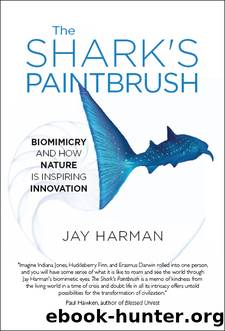The Shark's Paintbrush: Biomimicry and How Nature Is Inspiring Innovation by Jay Harman

Author:Jay Harman [Harman, Jay]
Language: eng
Format: epub
Tags: Business & Economics, Green Business, Nature, General, Science
ISBN: 9781857889314
Google: UQp9DAAAQBAJ
Publisher: Hachette UK
Published: 2013-06-25T00:40:44.698000+00:00
CLEAN AND GREEN
What would life be without flowers? So many of us enjoy growing, arranging, giving, or receiving their beauty. We use them in celebrations of life, marriage, birth, and death. We decorate our churches and bury our dead with them. We donât often stop to reflect that they are the very sex of plants, the only sex organs most societies allow people to handle in public. In common with the sexual parts of all other life-forms, their design and functionality are based on the proportions of natureâs spirals. Sap flows in spiraling veins. Leaves are spaced radially around their stems in spiralsâthe optimum arrangement to share available sunlight. Photosynthesis occurs in spirals and most often, the number of petals and seeds are Fibonacci numbersânatureâs ratio of spiral growth. Now an Arizona inventor, Dr. Joseph Hui, has developed a solar panel array in the shape of a lotus flower that even opens and closes.
The lotus is one of the most commercially successful sources of inspiration for biomimetic products. Apart from their intoxicating, heavenly fragrance, lotus plants are a symbol of purity in some major religions. More than two thousand years ago, for example, the Bhagavad Gita, once of Indiaâs ancient sacred scriptures, referred to lotus leaves as self-cleaning, but it wasnât until the late 1960s that engineers with access to high-powered microscopes began to understand the mechanism underlying the lotusâ dirt-free surface. German scientist Dr. Wilhelm Barthlott continued this research, finding microstructures on the surface of a lotus leaf that cause water droplets to bead up and roll away particles of mud or dirt. Like many biomimics, this insight came quickly, while its commercialization took many years more. The âLotus Effectââshort for the superhydrophobic (water-repelling) quality of the lotus leafâs micro-to nanostructured surfaceâhas become the subject of more than one hundred related patents and is one of the premier examples of successfully commercialized biomimicry.
Download
This site does not store any files on its server. We only index and link to content provided by other sites. Please contact the content providers to delete copyright contents if any and email us, we'll remove relevant links or contents immediately.
The Lonely City by Olivia Laing(4112)
Animal Frequency by Melissa Alvarez(3750)
All Creatures Great and Small by James Herriot(3506)
Walking by Henry David Thoreau(3227)
Exit West by Mohsin Hamid(3173)
Origin Story: A Big History of Everything by David Christian(3133)
COSMOS by Carl Sagan(2944)
How to Read Water: Clues and Patterns from Puddles to the Sea (Natural Navigation) by Tristan Gooley(2849)
Hedgerow by John Wright(2771)
The Inner Life of Animals by Peter Wohlleben(2763)
Origin Story by David Christian(2677)
How to Read Nature by Tristan Gooley(2657)
Project Animal Farm: An Accidental Journey into the Secret World of Farming and the Truth About Our Food by Sonia Faruqi(2654)
How to Do Nothing by Jenny Odell(2640)
A Forest Journey by John Perlin(2584)
Water by Ian Miller(2579)
The Plant Messiah by Carlos Magdalena(2451)
A Wilder Time by William E. Glassley(2358)
Forests: A Very Short Introduction by Jaboury Ghazoul(2331)
